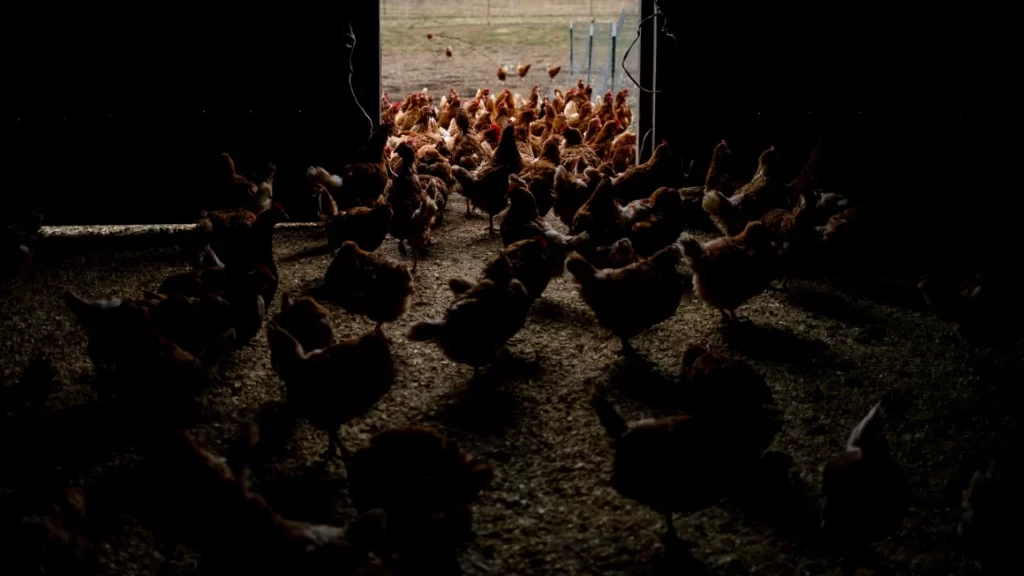According to three sources familiar with the situation, the Trump administration has failed to staff an office established by Congress to prepare the nation for future pandemics.
The White House Office of Pandemic Preparedness and Response Policy (OPPR) was created by Congress in 2022 in response to the missteps that led to a sluggish response to the Covid-19 pandemic.
OPPR, which once had a staff of approximately 20 people, was coordinating the country’s response to bird flu and other threats until January 20, including holding regular interagency meetings to share plans.
“We did it very much behind the scenes,” said Dr. Paul Friedrichs, a physician and retired Air Force major general who served as OPPR’s director during the Biden administration.
Related article
Trump’s got a bird flu plan. So when will eggs stop costing so much?
As of this week, only one staffer remains, and it is unclear to whom that person reports, according to a source who spoke on the condition of anonymity because they were not authorized to disclose the information. OPPR’s pages have also been removed from the White House website.
The new administration has not completely halted the country’s response to bird flu, but recent agency announcements and interviews with government sources indicate that its focus has shifted. For example, a primary goal of the response now is to reduce egg prices rather than addressing the spread of the virus or preparing for a worst-case scenario where the virus mutates and spreads easily from person to person.
OPPR exists “in name only,” said a source familiar with the office’s status who worked in the White House during the previous administration. “It has fallen into the abyss.”
Trump Downsizes Pandemic Planning
President Donald Trump disbanded a similar White House pandemic unit in 2018 and faced heavy criticism for the move when Covid-19 struck the U.S.
Despite this, in an interview with Time magazine during his campaign in April, Trump stated that he would likely disband OPPR if elected because it was expensive and potentially wasteful, given the difficulty of predicting pandemics.
In reality, Friedrichs said, OPPR operated on a very limited budget. The office was established without a dedicated budget. “That was one of the real challenges,” said Friedrichs, who was the office’s inaugural director.
Related article
H5N1 bird flu virus is infectious in raw milk cheese for months, posing risk to public health, study shows
Eventually, Congress added funds to the Executive Office of the President’s budget, but they were not specifically allocated to OPPR. Friedrichs estimated that if the office performed all its assigned functions, it would cost approximately $6.8 million. However, Congress never appropriated these funds because the government has been operating under a series of temporary stopgap measures called continuing resolutions since the office’s creation in 2022.
OPPR was staffed by individuals detailed, or assigned, from other organizations, which agreed to continue paying their salaries while they worked for OPPR. Nearly all have since moved on to other opportunities, Friedrichs said.
On January 20, his first day of his second term, Trump issued an executive order outlining the structure of his National Security Council, naming the director of the Office of Pandemic Preparedness and Response Policy as a member of the council.
During the administration’s initial weeks, the White House quietly hired Dr. Gerald Parker, a veterinarian with extensive government service and expertise in zoonotic diseases, or infections transmissible from animals to humans. His appointment was not formally announced but was reported in the media. Infectious disease experts praised the move to bring him into the administration.
Parker’s title is senior director for biosecurity and pandemic response. He sits on the National Security Council and has been attending meetings on bird flu, a source said.
The White House press office did not respond to requests for an interview with Parker and did not answer questions about Parker’s role or title, or whether his office has a budget or staff.
Friedrichs said he has not been able to meet with Parker since his appointment and never had the opportunity to hand over OPPR’s work to him.
Related article
‘Deadly consequences’: Health agencies reel from thousands of job cuts while critical research grants remain on hold
Over the year OPPR worked intensively on bird flu and other threats, Friedrichs said they created the infrastructure for the office and developed detailed plans for how the U.S. could collaborate across agencies to respond quickly to an outbreak, known as the Playbook for Biological Incident Response.
Friedrichs said they worked with numerous government agencies to gather best practices and lessons learned from past incident responses.
“Hopefully, that will allow future administrations to have all that in place for the first time,” he said.
OPPR’s H5N1 bird flu plans focused on infection surveillance and safeguarding human and animal health, but the Trump administration appears to be taking a different approach.
“Now, there are economic policy considerations in the mix that weren’t there before,” one source said.
In late February, U.S. Department of Agriculture Secretary Brooke Rollins announced that the agency would allocate $1 billion to a new strategy to combat avian flu and “deliver affordable eggs.”
A primary goal of the bird flu response is now to reduce egg prices rather than focusing on the spread of the virus.
Independent Office vs. a Seat on the Council
Because OPPR was created by statute, Trump cannot completely eliminate it.
“That’s been one of the big issues with so many of his executive orders, that he’s trying to undo what Congress has done,” said Lawrence Gostin, a distinguished professor of global health law at Georgetown University. “If Congress has set up an agency, he can’t dismantle it or transform it into another.”
However, by failing to staff or fund the office, Trump can significantly diminish its function and influence, experts said.
The National Security Council has long had a position dedicated to pandemic preparedness and biological threats.
Dr. Raj Panjabi was senior director for global health security and biodefense on the NSC before OPPR was created. After OPPR’s inception, he was tasked with global biosecurity at the NSC, while OPPR focused on domestic threats. He said the two offices worked closely together during the Biden administration.
Related article
US dodged a bird flu pandemic in 1957 thanks to eggs and luck. Can we do it again?
Panjabi said there are advantages to having pandemic preparedness within the NSC. One is that the NSC has a strong policy-making process, which facilitates action. Another is that NSC members have access to a different computer system, which is sometimes necessary for navigating government complexities.
“Now that it’s one person, in one office, I think that’s good,” said Panjabi, an associate physician in the division of global health equity at Brigham and Women’s Hospital and Harvard Medical School.
Sen. Patty Murray, a Democrat from Washington, co-authored the bill that created OPPR with former Sen. Richard Burr, a Republican from North Carolina. She said the office was intended to be reportable to Congress.
“Under the last administration, OPPR served, as intended, as the central hub coordinating a whole-of-government response to pandemic threats,” she said in a written statement to CNN. She met regularly with OPPR’s director, Friedrichs, to discuss the administration’s response to bird flu and other outbreaks.
“While President Trump cannot legally disband OPPR, as he has threatened to do, it is deeply concerning that he has moved the statutorily created OPPR into the NSC.
“As intended by law, OPPR is a separate, distinct office for a reason, which is especially relevant now as we are seeing outbreaks of measles, bird flu, and other serious and growing threats to public health,” Murray said. “This should be alarming to everyone.”
Pandemic Planning with Less Transparency
When it was a standalone office in the White House, OPPR’s activities were more transparent. The office was subject to open records requests under the Federal Records Act, but records of the National Security Council are covered by the Presidential Records Act, which protects them from disclosure.
Friedrichs hosted regular interagency calls between the U.S. Centers for Disease Control and Prevention, the USDA, the Administration for Strategic Preparedness and Response, the U.S. Food and Drug Administration, and the National Institutes of Health. Someone from the office of the secretary of the U.S. Department of Health and Human Services would also attend.
Related article
US government to begin expanded testing of milk supply to better track the spread of bird flu
Those meetings were held daily right after bird flu was first detected in dairy cattle in March 2024. They moved to three times a week and finally weekly by the end of the Biden administration.
“At the end of the day, bringing everybody together and having those meetings was incredibly important, so that we had a shared set of facts,” Friedrichs said. “When decisions were made, everyone understood why the decision was made, what facts were used to inform the decision.”
Some interagency meetings continue to be held about twice a month, one source said. It’s not clear who’s attending and which agencies are joining the calls.
HHS was also hosting regular news briefings on developments related to the outbreak, but there hasn’t been a briefing on bird flu since Trump took office.
Friedrichs said that in addition to setting up the office and developing a playbook for managing biological threats, the office spent $2.8 billion to fund a compensation program for dairy farmers and develop a milk testing program to spot new outbreaks, among other efforts.
The risk that bird flu poses to the general public is low, according to the CDC, but a major focus of OPPR’s efforts had been to prepare the nation for the event the virus changed or mutated enough to spread efficiently between people.
They had assembled subject-matter experts with the expertise needed to quickly initiate a response if the virus gained new abilities, including individuals with knowledge of supply chains, public health messaging, vaccine development, and distribution. That is all gone now, one expert said.
Related article
Bird flu variant found in Nevada cows shows signs of adaptation to mammals
OPPR also coordinated with the U.S. Department of Veterans Affairs, the Federal Emergency Management Agency, and industry partners to maintain therapeutics in the Strategic National Stockpile.
One of those efforts was to contract with Moderna to create a vaccine against H5N1, should it be necessary. Moderna has completed early-stage studies of its vaccine, called mRNA-1018, and plans to present its findings at upcoming medical meetings.
In February, Bloomberg News reported that U.S. health officials are reevaluating that $590 million contract.
“I’m very disappointed, candidly,” Friedrichs said. “One of the real challenges when a new pathogen emerges is that it takes time to produce therapeutics, and it takes time to produce vaccines.
“So we worked very closely with industry to try and find ways to fund research and clinical trials and make sure that we had a variety of options available if this virus became more dangerous,” he said. “Because we just don’t know what’s going to happen next with this virus.”



